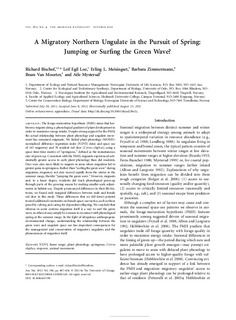A Migratory Northern Ungulate in the Pursuit of Spring: Jumping or Surfing the Green Wave?
Bischof, Richard; Loe, Leif Egil; Meisingset, Erling L.; Zimmermann, Barbara; Van Moorter, Bram; Mysterud, Atle
Journal article, Peer reviewed
Permanent lenke
http://hdl.handle.net/11250/134518Utgivelsesdato
2012Metadata
Vis full innførselSamlinger
Originalversjon
Bischof, R, Loe, L.E., Meisingset, E.L., Zimmermann, B., Van Moorter, B. & Mysterud, A. (2012). The American Naturalist, 180(4), 407-424Sammendrag
The forage-maturation hypothesis (FMH) states that herbivores migrate along a phenological gradient of plant development in order to maximize energy intake. Despite strong support for the FMH,
the actual relationship between plant phenology and ungulate movement has remained enigmatic. We linked plant phenology (MODIS–normalized difference vegetation index [NDVI] data) and space use of 167 migratory and 78 resident red deer (Cervus elaphus), using a space-time-time matrix of “springness,” defined as the instantaneous rate of green-up. Consistent with the FMH, migrants experienced substantially
greater access to early plant phenology than did residents. Deer were also more likely to migrate in areas where migration led to greater gains in springness. Rather than “surfing the green wave” during migration, migratory red deer moved rapidly from the winter to the summer range, thereby “jumping the green wave.” However, migrants
and, to a lesser degree, residents did track phenological green-up through parts of the growing season by making smaller-scale adjustments in habitat use. Despite pronounced differences in their life histories, we found only marginal differences between male and female
red deer in this study. Those differences that we did detect pointed toward additional constraints on female space-use tactics, such as those posed by calving and caring for dependent offspring.We conclude that whereas in some systems migration itself is a way to surf the green wave, in others it may simply be a means to reconnect with phenological spring at the summer range. In the light of ubiquitous anthropogenic environmental change, understanding the relationship between the green wave and ungulate space use has important consequences for the management and conservation of migratory ungulates and the
phenomenon of migration itself.
